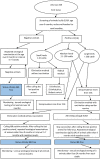Infectious Bovine Rhinotracheitis Control Program in Slovakia
- PMID: 34055957
- PMCID: PMC8149606
- DOI: 10.3389/fvets.2021.675521
Infectious Bovine Rhinotracheitis Control Program in Slovakia
Abstract
As for other European countries, IBR is a significant cause of financial losses in cattle in Slovakia. The State Veterinary and Food Administration of the Slovak Republic prepared a voluntary IBR control program for cattle farms in 1995, which was implemented in 1996. In subsequent years, 48-119 farms/year enrolled in the voluntary IBR control program. Since the end of 2006, the IBR control program became compulsory by law for all cattle farms in Slovakia. Serology was used to identify infected animals using a conventional ELISA amongst non-vaccinated cattle and a gE specific ELISA in cattle vaccinated with marker vaccine. Eradication is based on culling when the serological prevalence of IBR in a herd is below 15%. When the prevalence is higher than 15%, the culling is combined with the application of a marker vaccine. A radical method where all animals are slaughtered is used with the agreement of the farmer when appropriate, especially for very small herds. Depending upon the selected eradication method, the antibody positive cattle can be gradually replaced in the herds to eliminate financial losses due to the disease. The movement of cattle is under strict control requiring a health certificate issued by the state veterinary authority and the movement must be recorded in the central livestock registry. The next step for herds is monitoring to achieve official IBR-free status. Based on the official figures from The State Veterinary and Food Administration, 60.2% herds were free of IBR in Slovakia in 2020.
Keywords: IBR; Slovakia; cattle; control program; marker vaccine.
Copyright © 2021 Mandelik, Bires, Ozsvari, Hodnik and Vilcek.
Conflict of interest statement
The authors declare that the research was conducted in the absence of any commercial or financial relationships that could be construed as a potential conflict of interest.
Figures
Similar articles
-
Control programs for infectious bovine rhinotracheitis (IBR) in European countries: an overview.Anim Health Res Rev. 2021 Dec;22(2):136-146. doi: 10.1017/S1466252321000116. Anim Health Res Rev. 2021. PMID: 35076360 Review.
-
Field application of an indirect gE ELISA on pooled milk samples for the control of IBR in free and marker vaccinated dairy herds.BMC Vet Res. 2018 Dec 5;14(1):387. doi: 10.1186/s12917-018-1716-5. BMC Vet Res. 2018. PMID: 30518363 Free PMC article.
-
Dynamics of infection and immunity in a dairy cattle population undergoing an eradication programme for Infectious Bovine Rhinotracheitis (IBR).Prev Vet Med. 2008 Jun 15;85(1-2):68-80. doi: 10.1016/j.prevetmed.2008.01.001. Epub 2008 Mar 4. Prev Vet Med. 2008. PMID: 18304663
-
Surveillance of Infectious Bovine Rhinotracheitis in marker-vaccinated dairy herds: Application of a recombinant gE ELISA on bulk milk samples.Vet Immunol Immunopathol. 2017 Mar;185:1-6. doi: 10.1016/j.vetimm.2017.01.003. Epub 2017 Jan 24. Vet Immunol Immunopathol. 2017. PMID: 28241997
-
[The control of infectious bovine rhinotracheitis (IBR) in Switzerland from 1978 to 1988].Schweiz Arch Tierheilkd. 1989;131(7):397-407. Schweiz Arch Tierheilkd. 1989. PMID: 2678460 Review. German.
Cited by
-
Evaluation of an Immunization Protocol Using Bovine Alphaherpesvirus 1 gE-Deleted Marker Vaccines against Bubaline Alphaherpesvirus 1 in Water Buffaloes.Vaccines (Basel). 2023 Apr 24;11(5):891. doi: 10.3390/vaccines11050891. Vaccines (Basel). 2023. PMID: 37242994 Free PMC article.
References
LinkOut - more resources
Full Text Sources
Other Literature Sources
Research Materials


